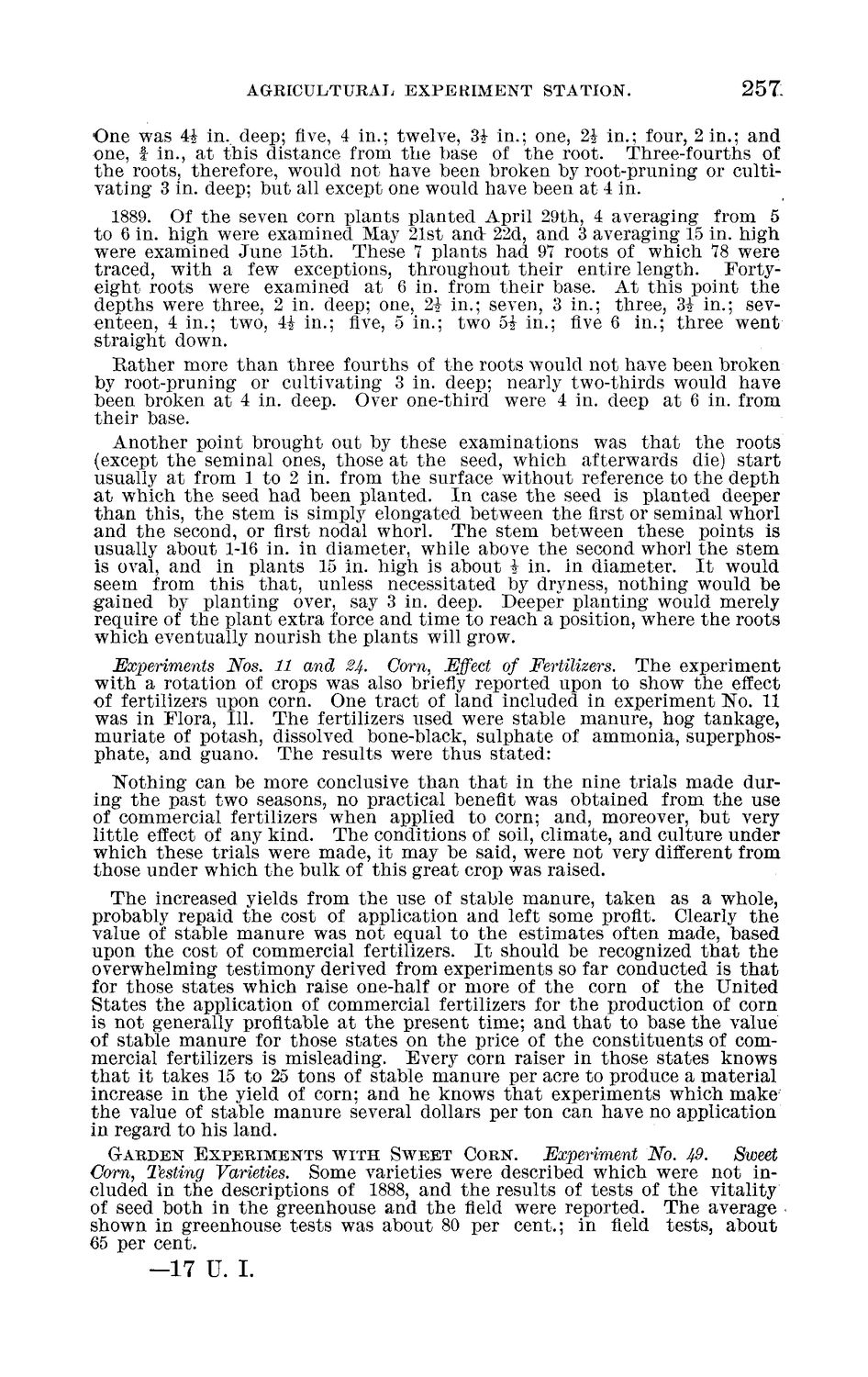| |
| |
Caption: Board of Trustees Minutes - 1890
This is a reduced-resolution page image for fast online browsing.

EXTRACTED TEXT FROM PAGE:
AGRICULTURAL EXPERIMENT STATION. 257 One was 41 in. deep; five, 4 in.; twelve, 31 in.; one, 21 in.; four, 2 in.; and one, t in., at this distance from t h e base of t h e root. Three-fourths of the roots, therefore, would not have been broken by root-pruning or cultivating 3 in. deep; but all except one would have been at 4 in. 1889. Of t h e seven corn plants planted April 29th, 4 averaging from 5 to 6 in. high were examined May 21st and 22d, and 3 averaging 15 in. high were examined June 15th. These 7 plants had 97 roots of which IS were traced, with a few exceptions, throughout their entire length. Fortyeight roots were examined a t 6 in. from their base. A t this point t h e depths were three, 2 in. deep; one, 21 in.; seven, 3 in.; three, 31 in.; seventeen, 4 in.; two, 41 in.; five, 5 in.; two 51 in.; five 6 in.; three went straight down. Eather more than three fourths of the roots would not have been broken by root-pruning or cultivating 3 in. deep; nearly two-thirds would have been broken a t 4 in. deep. Over one-third were 4 in. deep a t 6 in. from their base. Another point brought out by these examinations was t h a t the roots (except the seminal ones, those a t the seed, which afterwards die) start usually at from 1 to 2 in. from the surface without reference to the depth a t which t h e seed had been planted. I n case t h e seed is planted deeper than this, t h e stem is simply elongated between the first or seminal whorl and the second, or first nodal whorl. The stem between these points is usually about 1-16 in. in diameter, while above the second whorl the stem is oval, and in plants 15 in. high is about 1 in. in diameter. I t would seem from this that, unless necessitated by dryness, nothing would be gained by planting over, say 3 in. deep. Deeper planting would merely require of the plant extra force and time to reach a position, where the roots which eventually nourish the plants will grow. Experiments Nos. 11 and 24. Corn, Effect of Fertilizers. The experiment with a rotation of crops was also briefly reported upon to show the effect of fertilizers upon corn. One tract of land included in experiment No. 11 was in Flora, 111. The fertilizers used were stable manure, hog tankage, muriate of potash, dissolved bone-black, sulphate of ammonia, superphosphate, and guano. T h e results were thus stated: Nothing can be more conclusive than t h a t in the nine trials made during the past two seasons, no practical benefit was obtained from t h e use of commercial fertilizers when applied to corn; and, moreover, but very little effect of any kind. The conditions of soil, climate, and culture under which these trials were made, it may be said, were not very different from those under which the bulk of this great crop was raised. The increased yields from t h e use of stable manure, taken as a whole, probably repaid t h e cost of application and left some profit. Clearly t h e value of stable manure was not equal to t h e estimates often made, based upon t h e cost of commercial fertilizers. I t should be recognized t h a t t h e overwhelming testimony derived from experiments so far conducted is t h a t for those states which raise one-half or more of t h e corn of t h e United States t h e application of commercial fertilizers for t h e production of corn is not generally profitable a t t h e present time; and t h a t to base the value of stable manure for those states on t h e price of t h e constituents of commercial fertilizers is misleading. Every corn raiser in those states knows t h a t it takes 15 to 25 tons of stable manure per acre to produce a material increase in t h e yield of corn; and he knows t h a t experiments which make the value of stable manure several dollars per ton can have no application in regard to his land. G A R D E N E X P E R I M E N T S W I T H S W E E T CORN. Experiment No. 49. Sweet Corn, Testing Varieties. Some varieties were described which were not included in t h e descriptions of 1888, and the results of tests of t h e vitality of seed both in t h e greenhouse and t h e field were reported. The average shown in greenhouse tests was about 80 per cent.; in field tests, about 65 per cent. - 1 7 U. I.
| |